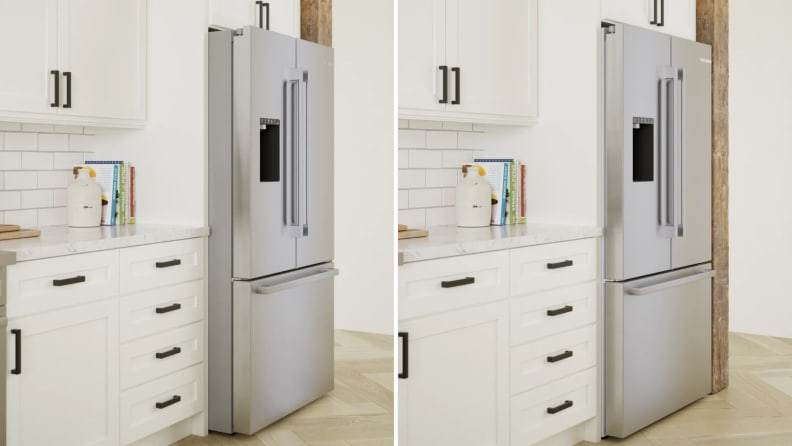What the heck is a counter depth refrigerator, and why would you want one?
There's a lot to know about counter depth fridges
 Credit:
Reviewed / Samsung
Credit:
Reviewed / Samsung
Products are chosen independently by our editors. Purchases made through our links may earn us a commission.
There are several different styles of refrigerators to consider when buying a new fridge, but the biggest deciding factor may be how it will fit in your kitchen. Whether you want to make a small kitchen feel more open, or prefer low-profile appliances, there are many reasons you may want to consider a counter-depth refrigerator.
What is a counter-depth refrigerator?
A standard countertop is 24 inches deep, and the body of a counter-depth refrigerator—not counting the doors or handles—is usually close to that depth.
By comparison, the depth of a standard refrigerator is usually at least 30 inches deep—and in many cases, much deeper. The width and height typically remain the same no matter the depth, although measuring in every direction is a must!
Unfortunately, there is no standard for what defines “counter depth”— but if you don’t want your fridge to stand out six inches from your counters or cabinets, a counter-depth model is your best bet.
How deep is a counter-depth refrigerator?

Bosch gives a very helpful primer, with example images, of the difference between standard-depth and counter-depth refrigerators.
There is a relatively wide range of depths that fall into the category of counter-depth refrigerators. The original definition is 24 to 25 inches deep, however many brands now call anything less than 30 inches deep “counter depth.”
Many brands have detailed explanations of counter-depth versus standard-depth models, so it's good to research each brand you're considering and look specifically at the true dimensions of every model.
If a fridge is labeled “counter-depth” that doesn’t necessarily mean it will sit perfectly flush with your counter or cabinets. It all depends on the overall depth of the fridge, and the type of hinges it has.
The doors of many fridge styles, especially side-by-sides and French-door fridges, can’t open if they’re pushed right up to cabinetry or counters. In addition, a counter depth fridge still needs the same breathing room as a standard depth model, so the back of the fridge should be at least an inch from the wall.
That means some counter-depth fridges will stick out—“proud” in designer lingo—at least three or four inches.
Can a counter-depth fridge sit truly flush with cabinets?
Yes, there are fridges that are made to sit flush with cabinetry. The most common of these styles are high-end built-in models, which can cost upwards of $4,000, not including professional installation.
There are also some fridges made with articulating hinges, which don’t require clearance to open. This allows the entire fridge—doors and all—to be encased by cabinetry. Just be aware that you’ll still need to allow for the proper air flow at the back of the fridge.
What is the difference between counter-depth and standard-depth fridges?
Besides the obvious difference in exterior depth, counter-depth fridges also have less interior square footage of storage. That doesn’t, however, mean that they’re less useful than a standard-depth fridge. Many offer extra organizational features to bolster storage when sacrificing square footage.
Consider two otherwise identical fridges, the Samsung Bespoke AI 4-Door French Door RF90F23AE in standard depth versus the same model in counter depth. Including doors and handles, the standard-depth model is 34.25 inches deep, while the counter-depth model is 28.75 inches deep. That’s almost half a foot of floor space saved.
The tradeoff? Less storage capacity. Samsung measures the capacity for the counter-depth model, including fridge, freezer, and flex drawer, is 22.5 cubic feet. The full depth model is said to have 28.6 cubic feet of total space.
Most standard-depth refrigerators claim to hold between 26 and 32 cubic feet of items, while the majority of counter-depth fridges claim 20 and 24 cubic feet of capacity. To help put this into context, a gallon of milk takes up .13 cubic feet of space, while a half-gallon of ice cream takes up .07 cubic feet.
Even if you’re technically sacrificing some storage space in a counter-depth fridge, they are often more energy efficient and easier to organize, which can lead to a reduction in food waste. You can’t use what you can’t see, and a counter-depth fridge keeps more contents visible thanks to shallower shelves.
While there’s a lot to consider when purchasing a counter-depth fridge, one can save considerable space and make a kitchen feel more open, especially in a galley kitchen.
Interested in a counter-depth fridge? Check out our top lab-tested picks for the best counter depth fridges tested by appliance expters.



